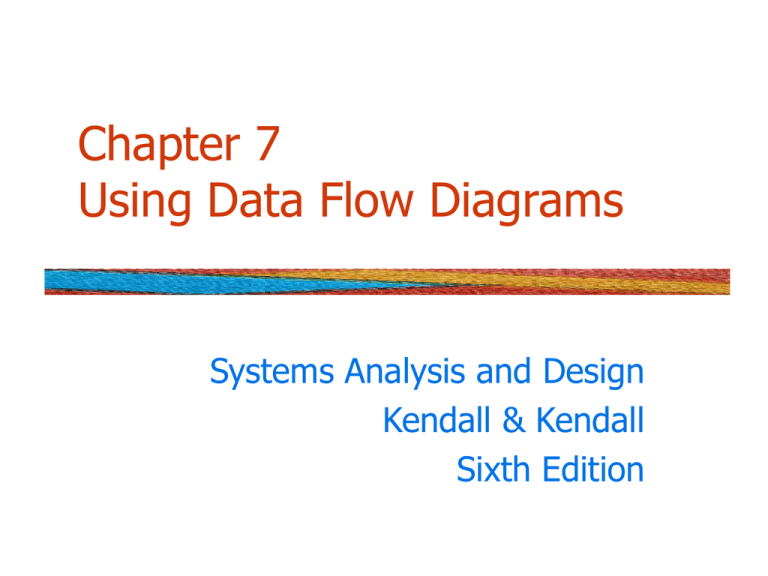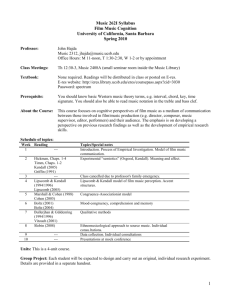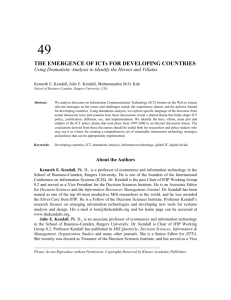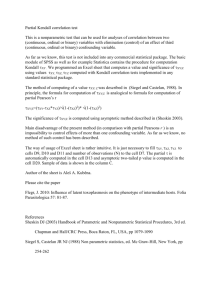
Chapter 7
Using Data Flow Diagrams
Systems Analysis and Design
Kendall & Kendall
Sixth Edition
Basic Symbols
Kendall & Kendall
© 2005 Pearson Prentice Hall
7-2
External Entities
• Represent people or organizations
outside of the system being studied
• Shows the initial source and final
recipient of data and information
• Should be named with a noun,
describing that entity
Customer
Kendall & Kendall
© 2005 Pearson Prentice Hall
7-3
External Entities (Continued)
• External entities may be:
• A person, such as CUSTOMER or STUDENT.
• A company or organization, such as BANK
or SUPPLIER.
• Another department within the company,
such as ORDER FULFILLMENT.
• Another system or subsystem, such as the
INVENTORY CONTROL SYSTEM.
Kendall & Kendall
© 2005 Pearson Prentice Hall
7-4
Processes
• Represent either:
1
Add New
Customer
• A whole system
• A subsystem
• Work being done, an activity
2
Customer
Inquiry
Subsystem
• Names should be in the form verbadjective-noun
• The exception is a process that represents
an entire system or subsystem.
Kendall & Kendall
© 2005 Pearson Prentice Hall
7-5
Data Stores
• Name with a noun, describing the data
• Data stores are usually given a unique
reference number, such as D1, D2, D3.
• Include any data stored, such as:
• A computer file or database.
• A transaction file .
Customer
D1
Master
• A set of tables .
• A manual file of records.
Kendall & Kendall
© 2005 Pearson Prentice Hall
7-6
New Customer
Data Flow
•
•
•
•
Customer Record
Data flow shows the data about a person,
place, or thing that moves through the
system.
Names should be a noun that describes the
data moving through the system.
Arrowhead indicates the flow direction.
Use double headed-arrows only when a
process is reading data and updating the data
on the same table or file.
Kendall & Kendall
© 2005 Pearson Prentice Hall
7-7
Creating Data Flow Diagrams
Detailed data flow diagrams may be
developed by (continue):
• Examining the data flow to or from a data
store.
• Analyzing a well-defined process for data
requirements and the nature of the
information produced.
• Noting and investigating unclear areas.
Kendall & Kendall
© 2005 Pearson Prentice Hall
7-8
Data Flow Diagram Levels
• Data flow diagrams are built in layers.
• The top level is the Context level.
• Each process may explode to a lower
level.
• The lower level diagram number is the
same as the parent process number.
• Processes that do not create a child
diagram are called primitive.
Kendall & Kendall
© 2005 Pearson Prentice Hall
7-9
Context-Level Data Flow
Diagram
• It contains only one process,
representing the entire system.
• The process is given the number zero.
• All external entities are shown on the
context diagram as well as major data
flow to and from them.
• The diagram does not contain any data
stores.
Kendall & Kendall
© 2005 Pearson Prentice Hall
7-10
Child Diagrams (Continued)
• A lower-level diagram may contain data
stores not shown on the parent process,
such as:
• A file containing a table of information
(such as a tax table).
• A file linking two processes on the child
diagram.
• Minor data flow, such as an error line,
may be included on a child diagram.
Kendall & Kendall
© 2005 Pearson Prentice Hall
7-11
Child Diagrams (Continued)
• An interface data flow is data that are
input or output from a child diagram
that matches the parent diagram data
flow.
• Processes that do not create a child
diagram are called primitive processes.
• Logic is written for these processes.
Kendall & Kendall
© 2005 Pearson Prentice Hall
7-12
Data Flow Diagram Errors
• The following conditions are errors that
occur when drawing a data flow
diagram:
• A process with only input data flow or
only output data flow from it.
2
Add
New
Customer
1
Add
New
Customer
Kendall & Kendall
© 2005 Pearson Prentice Hall
7-13
Data Flow Diagram Errors
(Continued)
• Data stores or external entities are
connected directly to each other, in any
combination.
Customer
D1
Customer
Vendor
D2
Vendor Master
Kendall & Kendall
© 2005 Pearson Prentice Hall
7-14
Data Flow Diagram Errors
(Continued)
• Incorrectly labeling data flow or objects
• Examples are:
• Labels omitted from data flow or objects.
• Data flow labeled with a verb.
• Processes labeled with a noun.
• Too many processes on a data flow
diagram.
• Nine is the suggested maximum.
Kendall & Kendall
© 2005 Pearson Prentice Hall
7-15
Logical Data Flow Diagrams
• Logical data flow diagrams show how
the business operates.
• They have processes that would exist
regardless of the type of system
implemented.
Kendall & Kendall
© 2005 Pearson Prentice Hall
7-16
Data Flow Diagram
Progression
The progression of creating data flow
diagrams is:
• Create a logical DFD of the current system.
• Next add all the data and processes not in
the current system that must be present in
the new system.
• Finally derive the physical data flow
diagram for the new system.
Kendall & Kendall
© 2005 Pearson Prentice Hall
7-17
Data Flow
Diagram
Progression
Kendall & Kendall
© 2005 Pearson Prentice Hall
7-18
Logical Data Flow Diagrams
Advantages
Advantages of logical DFDs are:
• Better communication with users.
• More stable systems, since the design is
based on a business framework.
• Increased understanding of the business
by analysts.
• The system will have increased flexibility
and be easier to maintain.
• Elimination of redundancy.
Kendall & Kendall
© 2005 Pearson Prentice Hall
7-19
Physical Data Flow Diagrams
•
Physical data flow diagrams show how the
system operates or how the new system will
be implemented.
Physical data flow diagrams include:
• Clarifying which processes are manual and which
•
•
Kendall & Kendall
are automated.
Describing processes in greater detail.
Sequencing processes in the order they must be
executed.
© 2005 Pearson Prentice Hall
7-20
Physical Data Flow Diagrams
Physical data flow diagrams include
(continued):
• Temporary data stores and transaction
files.
• Specifying actual document and file names.
• Controls to ensure accuracy and
completeness.
Kendall & Kendall
© 2005 Pearson Prentice Hall
7-21
Use Case and Data Flow
Diagrams
• A use case is another approach used to
develop a data flow diagram.
• A use case is used to create a data flow
diagram by providing a framework for
obtaining processes, input, output, and
data stores required for user activities.
• A use case shows the steps performed
to accomplish a task.
Kendall & Kendall
© 2005 Pearson Prentice Hall
7-22







